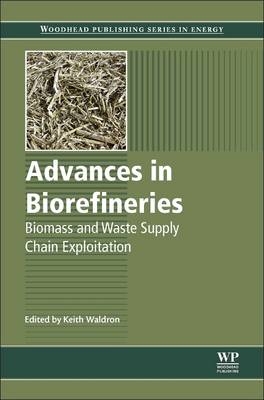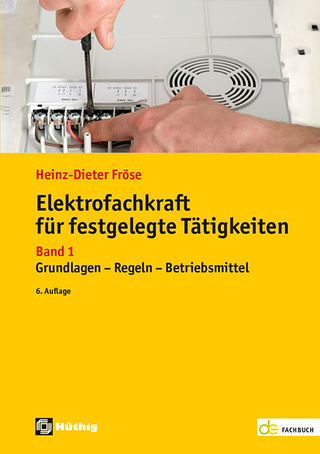
Advances in Biorefineries
Woodhead Publishing Ltd (Verlag)
978-0-85709-521-3 (ISBN)
- Titel ist leider vergriffen;
keine Neuauflage - Artikel merken
Biorefineries are an essential technology in converting biomass into biofuels or other useful materials. Advances in Biorefineries provides a comprehensive overview of biorefining processing techniques and technologies, and the biofuels and other materials produced.
Part one focuses on methods of optimizing the biorefining process and assessing its environmental and economic impact. It also looks at current and developing technologies for producing value-added materials. Part two goes on to explore these materials with a focus on biofuels and other value-added products. It considers the properties, limitations, and practical applications of these products and how they can be used to meet the increasing demand for renewable and sustainable fuels as an alternative to fossil fuels.
Advances in Biorefineries is a vital reference for biorefinery/process engineers, industrial biochemists/chemists, biomass/waste scientists and researchers and academics in the field.
Keith Waldron is Research Leader and Director of the NRP Biorefinery Centre at the Institute of Food Research, UK.
Contributor contact details
Woodhead Publishing Series in Energy
Foreword
Preface
Part I: Development and optimisation of biorefining processes
1. Green chemistry, biorefineries and second generation strategies for re-use of waste: an overview
Abstract:
1.1 Introduction
1.2 Introduction to biorefineries
1.3 New renewable feedstocks
1.4 Conclusion and future trends
1.5 Sources of further information and advice
1.6 References
2. Techno-economic assessment (TEA) of advanced biochemical and thermochemical biorefineries
Abstract:
2.1 Introduction
2.2 Biorefinery economic assessment
2.3 Trade of biomass and subsidies
2.4 Market establishment: national/regional facilities
2.5 Conclusion and future trends
2.6 References
3. Environmental and sustainability assessment of biorefineries
Abstract:
3.1 Introduction
3.2 Methodological foundations of environmental and sustainability assessment of technologies
3.3 Life cycle assessment (LCA) for biorefineries
3.4 Sustainability issues: synopsis of results from assessment of economic and social aspects
3.5 Conclusion and future trends
3.6 References
4. Biorefinery plant design, engineering and process optimisation
Abstract:
4.1 Introduction
4.2 Microalgae biomass for biorefinery systems
4.3 Planning, design and development of biorefinery systems
4.4 Case study: a second generation lignocellulosic biorefinery (Inbicon® Biorefinery)
4.5 Upgrading biorefinery operations
4.6 Optimising biorefinery processes using process analysis
4.7 Conclusion and future trends
4.8 References
5. Current and emerging separations technologies in biorefining
Abstract:
5.1 Introduction
5.2 Separations technologies
5.3 Removal of impurities from lignocellulosic biomass hydrolysate liquor for production of cellulosic sugars
5.4 Glycerin desalting as a value added co-product from biodiesel production
5.5 Succinic acid production
5.6 Solvent extraction: the example of recovery of value added proteins from distiller’s grains and solubles (DGS)
5.7 Biofuels recovery by solvent extraction in an ionic liquid assisted membrane contactor
5.8 Emerging trends in separations technology for advanced biofuels
5.9 Performance indices
5.10 Conclusion
5.11 Acknowledgements
5.12 References
6. Catalytic processes and catalyst development in biorefining
Abstract:
6.1 Introduction
6.2 Catalysts for depolymerization of biomass
6.3 Catalysts for biomass products upgrading
6.4 Conclusion and future trends
6.5 References
7. Enzymatic processes and enzyme development in biorefining
Abstract:
7.1 Introduction
7.2 Biochemical conversion
7.3 Development of enzyme technology and techniques
7.4 Optimizing enzymes
7.5 Benchmarking enzymes and enzymatic conversion processes
7.6 Advantages and limitations of techniques
7.7 Conclusion and future trends
7.8 Sources of further information and advice
7.9 References
8. Biomass pretreatment for consolidated bioprocessing (CBP)
Abstract:
8.1 Introduction
8.2 Process configurations for biofuel production
8.3 Models for consolidated bioprocessing (CBP)
8.4 Microorganisms, enzyme systems, and bioenergetics of CBP
8.5 Organism development
8.6 Conclusion
8.7 References
9. Developments in bioethanol fuel-focused biorefineries
Abstract:
9.1 Introduction
9.2 Ethanol biorefineries
9.3 The lignocellulose to ethanol process
9.4 Design options for biorefining processes
9.5 Process intensification: increasing the dry-matter content
9.6 Different types of ethanol biorefineries
9.7 Future trends
9.8 Conclusion
9.9 Sources of further information and advice
9.10 References
10. Developments in cereal-based biorefineries
Abstract:
10.1 Introduction
10.2 Wheat-based biorefineries
10.3 Fuel ethanol production from wheat
10.4 Succinic acid production from wheat
10.5 Polyhydroxyalkanoate (PHA) production from wheat
10.6 Utilization of wheat straw
10.7 Conclusion and future trends
10.8 Sources of further information and advice
10.9 Acknowledgements
10.10 References
11. Developments in grass-/forage-based biorefineries
Abstract:
11.1 Introduction
11.2 Overview of grass-/forage-based biorefineries
11.3 Field to biorefinery – impact of herbage chemical composition
11.4 Green biorefinery products
11.5 Acknowledgements
11.6 References
12. Developments in glycerol byproduct-based biorefineries
Abstract:
12.1 Introduction
12.2 Composition and purification of glycerol produced from biodiesel
12.3 Applications of glycerol in the fuel sector
12.4 Glycerol as raw material for the chemical industry
12.5 Conclusions and future trends
12.6 Sources of further information
12.7 References
Part II: Biofuels and other added value products from biorefineries
13. Improving the use of liquid biofuels in internal combustion engines
Abstract:
13.1 Introduction
13.2 Competing fuels and energy carriers
13.3 Market penetration of liquid biofuels
13.4 Use of liquid biofuels in internal combustion engines
13.5 Vehicle and blending technologies for alcohol fuels and gasoline
13.6 Future provision of renewable liquid fuels
13.7 Conclusion
13.8 Acknowledgements
13.9 References and further reading
13.10 Appendix: List of abbreviations
14. Biodiesel and renewable diesel production methods
Abstract:
14.1 Introduction
14.2 Overview of biodiesel and renewable diesel
14.3 Renewable diesel production routes
14.4 Biodiesel production routes
14.5 Traditional and emerging feedstocks
14.6 Feedstock quality issues
14.7 Advantages and limitations of biodiesel
14.8 Conclusion and future trends
14.9 Sources of further information and advice
14.10 References
15. Biomethane and biohydrogen production via anaerobic digestion/fermentation
Abstract:
15.1 Introduction
15.2 Basic principles of biogas and hydrogen production
15.3 Biogas and biohydrogen production: technological aspects
15.4 Production of biogas (methane) and biohydrogen from different feedstocks
15.5 Current status and limitations
15.6 Future trends
15.7 Sources of further information and advice
15.8 References
16. The production and application of biochar in soils
Abstract:
6.1 Introduction
16.2 Effects of application of biochar to soil
16.3 Agricultural uses of biochar
6.4 Production of biochar
16.5 Larger-scale commercial production of biochar
16.6 Testing biochar properties
16.7 Markets and uses for biochar
16.8 Conclusion and future trends
16.9 References
6.10 Appendix: IBI; Standardized product definition and product testing guidelines for biochar used in soil
17. Development, properties and applications of high-performance biolubricants
Abstract:
17.1 Introduction
17.2 Markets for lubricants
17.3 Biolubricant performance requirements
17.4 Applications of biolubricants
17.5 Feedstocks for biolubricants: key properties
17.6 Chemical modifications of biolubricant feedstocks
17.7 Future trends
17.8 Conclusion
17.9 Acknowledgements
17.10 References
18. Bio-based nutraceuticals from biorefining
Abstract:
18.1 Introduction
18.2 Lipid-based nutraceuticals
18.3 Protein and peptide-based nutraceuticals
18.4 Carbohydrate-based nutraceuticals
18.5 Other nutraceuticals
18.6 Conclusion and future trends
18.7 References
19. Bio-based chemicals from biorefining: carbohydrate conversion and utilisation
Abstract:
19.1 Introduction
19.2 Sustainable carbohydrate sources
19.3 Chemical hydrolysis of cellulose to sugars
19.4 Types and properties of carbohydrate-based chemicals
19.5 Routes to market for bio-based feedstocks
19.6 Conclusion and future trends
19.7 Sources of further information and advice
19.8 References
20. Bio-based chemicals from biorefining: lignin conversion and utilisation
Abstract:
20.1 Introduction
20.2 Structure and properties of lignin
20.3 Traditional processes for the production of lignin
20.4 Emerging processes for the production of lignin
20.5 Applications of lignin and lignin-based products: an overview
20.6 Future trends
20.7 Sources of further information and advice
20.8 References
21. Bio-based chemicals from biorefining: lipid and wax conversion and utilization
Abstract:
21.1 Introduction
21.2 Types and properties of lipids and waxes
21.3 Sources of lipids and waxes
21.4 Methods to extract and analyze lipids and waxes
21.5 Utilization of lipids and waxes
21.6 Conclusion and future trends
21.7 References
22. Bio-based chemicals from biorefining: protein conversion and utilisation
Abstract:
22.1 Introduction
22.2 Protein and amino acid sources derived from biofuel production
22.3 Protein isolation, hydrolysis and isolation of amino acid chemical feedstocks
22.4 (Bio)chemical conversion of amino acids to platform and speciality chemicals
22.5 Alternative and novel feedstocks and production routes
22.6 Conclusion and future trends
22.7 References
23. Types, processing and properties of bioadhesives for wood and fibers
Abstract:
23.1 Introduction
23.2 Tannin adhesives
23.3 Lignin adhesives
23.4 Mixed tannin-lignin adhesives
23.5 Protein adhesives
23.6 Carbohydrate adhesives
23.7 Unsaturated oil adhesives
23.8 Wood welding without adhesives
23.9 Conclusion and future trends
23.10 References
24. Types, properties and processing of bio-based animal feed
Abstract:
24.1 Introduction
24.2 Background
24.3 Types and properties of bio-based feed ingredients
24.4 Impact of processing technology on co-product quality
24.5 Improving feedstocks, processes and yields
24.6 Regulatory issues
24.7 Future trends
24.8 Sources of further information and advice
24.9 References
25. The use of biomass to produce bio-based composites and building materials
Abstract:
25.1 Introduction
25.2 Fibrous plants
25.3 Fiber types and isolation
25.6 Improving performance properties
25.7 Conclusion and future trends
25.8 Sources of further information and advice
25.9 References
26. The use of biomass for packaging films and coatings
Abstract:
26.1 Introduction
26.2 Components of packaging films and coatings from the biomass
26.3 Processes for producing bio-based films
26.4 Processes for producing edible coatings
26.5 Products from biomass as film and/or coating matrices
26.6 Products from biomass as film plasticizers
26.7 Products from biomass as crosslinking agents for packaging materials
26.8 Products from biomass as reinforcements for packaging materials
26.9 Future trends
26.10 Conclusion
26.11 Acknowledgements
26.12 References
Index
| Erscheint lt. Verlag | 3.4.2014 |
|---|---|
| Reihe/Serie | Woodhead Publishing Series in Energy |
| Verlagsort | Cambridge |
| Sprache | englisch |
| Maße | 156 x 234 mm |
| Gewicht | 1480 g |
| Themenwelt | Technik ► Elektrotechnik / Energietechnik |
| ISBN-10 | 0-85709-521-8 / 0857095218 |
| ISBN-13 | 978-0-85709-521-3 / 9780857095213 |
| Zustand | Neuware |
| Informationen gemäß Produktsicherheitsverordnung (GPSR) | |
| Haben Sie eine Frage zum Produkt? |
aus dem Bereich


